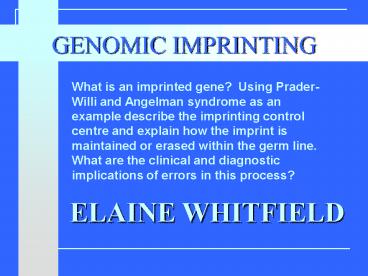GENOMIC IMPRINTING - PowerPoint PPT Presentation
1 / 13
Title:
GENOMIC IMPRINTING
Description:
GENOMIC IMPRINTING What is an imprinted gene? Using Prader-Willi and Angelman syndrome as an example describe the imprinting control centre and explain how the ... – PowerPoint PPT presentation
Number of Views:377
Avg rating:3.0/5.0
Title: GENOMIC IMPRINTING
1
GENOMIC IMPRINTING
What is an imprinted gene? Using Prader-Willi
and Angelman syndrome as an example describe the
imprinting control centre and explain how the
imprint is maintained or erased within the germ
line. What are the clinical and diagnostic
implications of errors in this process?
ELAINE WHITFIELD
2
What Is an Imprinted Gene?
- A gene which is expressed from only one allele in
a parent-specific manner due to epigenetic
modification - Mouse embryo manipulation in vitro provided first
clear evidence for the phenomenom of gametic
imprinting - Paternal genome more important for proliferation
of the extraembryonic tissues - Maternal genome more important for
post-implantation embryonic development
3
- Selective breeding studies in mice and naturally
occurring cases of UPD in humans have shown
that only a minor proportion of the genome is
imprinted - 80 human genes have been determined to be
imprinted to date - Imprinted genes are clustered within the genome
- Imprinting centres - specific DNA sequences
identify some of these clusters as targets of the
imprinting machinery of the gamete
4
How Does Imprinting Occur?
- Genes are stamped so that the expression of the
inherited information is modified according to
whether it is passed on via the egg or sperm - Differential allele-specific DNA methylation is
present in imprinted regions localised to
differentially methylated regions (DMRs) - The Prader-Willi / Angelman region on chromosome
15 is a well-characterised imprinted region
5
Prader-Willi Syndrome
- PWS - 1 in 20 000 births failure to thrive
during infancy, hyperphagia and obesity
during early childhood, mental retardation
behavioural problems - Due to the loss of paternally expressed genes in
2Mb imprinted domain at 15q11-q13 - No single gene has been shown to cause PWS when
its expression is lost - PWS Imprinting Control Region (ICR) mapped to a
segment of 4kb that spans 1st exon and promoter
of SNRPN/SNURF locus - 70 cases of PWS due to paternal deletions in
15q11-13 region - 20-30 cases due to maternal UPD
- 5-10 cases due to paternally derived
microdeletions of the ICR, loss of imprinting at
the ICR (de novo methylation of the paternal
allele) or balanced translocations that disrupt
SNURF/SNRPN gene
6
Angelman Syndrome
- AS - 1 in 15 000 births mental retardation,
speech impairment behavioural abnormalities - AS arises from the loss of a single gene
maternally expressed UBE3A which is imprinted
only in the brain - 65-70 cases maternally derived deletions of
15q11-q13 - 5 cases caused by paternal UPD
- 10 cases maternal UBE3A mutations
- 5 cases imprinting defects
- 10 caused by an unknown defect
7
The PWAS region of chr. 15q11-q13
8
(No Transcript)
9
Erasure re-establishment of the imprint in the
germ line
10
Diagnosis of Prader-Willi / Angelman Syndrome
- DNA methylation testing to detect abnormal
parent specific imprinting will detect gt99 of
PWS and 75 of AS affected individuals - If paternal expression is shown to be absent
PWS - If maternal expression is shown to be absent AS
- If normal methylation in ? AS direct mutation
analysis of UBE3A may be considered
11
174bp 100bp
12
- If PWS or AS are detected it is important to
determine the mechanism responsible - De novo deletions and UPD have a very low
recurrence risk - Imprinting mutations have a recurrence risk of up
to 50 - UBE3A mutations have recurrence risk as high as
50 - AS cases with no cause identified-recurrence risk
is high and no testing available
13
In Conclusion
- Imprinting is a complex process which is critical
for normal development - Few genes are imprinted these are clustered
- Defects in imprinting are implicated in abnormal
fetal growth and disease. - Mechanism is important to discover as recurrence
risk may be very high

